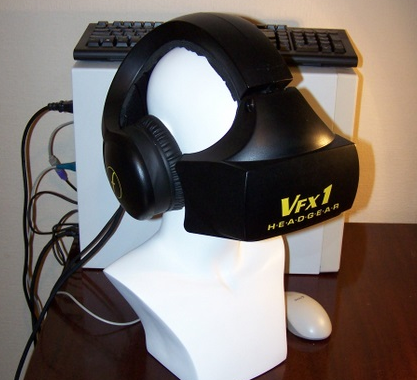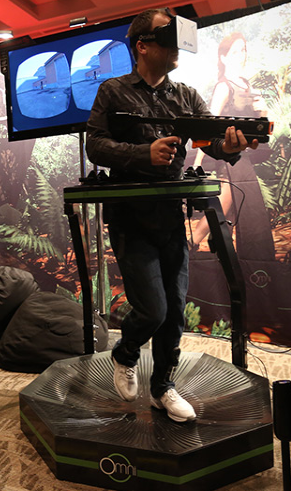
Virtual Reality has been a joke for years. For all the derision heaped on nonexistent flying cars, jetpacks, and cures for cancer, no seemingly straightforward bit of technology has been vaporware for so long. 1992's film The Lawnmower Man enticed us with the idea of entering a fictional world, a facsimile of Star Trek's Holodeck, without the need for matter/energy conversion or force fields. But the unfeasibility of the technology in 1992 is fairly obvious when you look at the problems: virtual reality headsets, the central component of such a system, would have had to be made of cathode ray tubes back in the time of Lawnmower Man. CRTs are heavy, huge, power hungry, high voltage, glass monstrosities—they therefore make bad apparel. Moreover, the devices needed a way of tracking the orientation of the headset, so that when you turn your head the image in front of your eyes changes accordingly. No good way existed to do this with any real speed, certainly not cheaply. And two of them are needed for stereoscopic (3D) viewing. VR headsets could be produced, but were so bad and expensive that they never really got beyond the lab or high-tech industries.
In the late 90s and early 2000s, head mounted displays using LCDs were released by several manufacturers, but  these were normally quite low fidelity and/or obscenely expensive. Large, low density TFT-LCD screens, often backlit with hot lamps, were beginning to be affordable, but nothing small and energy efficient. Consumer models that were true head-tracking displays never materialized in anything above 600 vertical pixel, well below that needed for realism. There wasn't a large market for small high-density screens.
these were normally quite low fidelity and/or obscenely expensive. Large, low density TFT-LCD screens, often backlit with hot lamps, were beginning to be affordable, but nothing small and energy efficient. Consumer models that were true head-tracking displays never materialized in anything above 600 vertical pixel, well below that needed for realism. There wasn't a large market for small high-density screens.
Screens weren't the only problems by a long shot. Lawnmower Man may have shown Pierce Brosnan a terrifying image of his test subject Jeff Fahey, but the graphics were deliberately crude and abstract due to the limitations of computer, and especially graphics, processing, at the time. The technology that would be needed to allow for walking and hand movement would have been no more sophisticated than a joystick; practical motion capture like that used in The Lord of the Rings was quite a bit off, requiring fast, high definition digital photography and computers to parse the data in real time.
All of these problems have been solved. In fact, you've likely already interacted with many of the solutions. And now there are people preparing products that combine the technologies into inexpensive, amazingly lifelike virtual reality. It's coming next year, and a lot of people have already been using it for months. It's going to be incredible, a watershed moment for interactive media.
The solution begins with a device my actual grandmother literally owns: an iPhone. Specifically, the iPhone is a high-pixel-density screen married to a number of micro-electromechanical sensors and a battery with a whopping energy density despite being small and lightweight. It can sense orientation, display a high definition image, and doesn't require a huge power cord or hefty weight to do it; that's practically all a head-mounted display has to do. Put two of these suckers into a piece of plastic, add some optics, and you have the Oculus Rift.
To make a realistic, brain fooling virtual reality setup, you have to get several things right. First, the eye has to focus far away without simply making the screen look far away, which means that nonspherical lenses have to be made. This allows the screens to be physically near the eye but appear to be far from it, and still retain very large field of view. Peripheral vision has to work, and it does with the Rift. The head tracking is incredibly fast, fast enough to be capable of fooling people into thinking the experience is real. Among those people who have ordered and received the Developer's Kit, many report that going inside the Rift is like going into another world; exiting it is disorienting, as you feel you are shifting from one reality to another. If someone taps on your shoulder while you're in the Rift, things get very uncomfortable. Horror games are TOO scary because all of a sudden you really feel like you're there, in danger.
The Rift is also doing what it needs to do to integrate with current game makers, people who have spent the past 20 years pushing for huge amounts of graphical computing power to run their sophisticated 3D game engines. Oculus has made the task of programming a Rift game purportedly easy, something that past head-mounted displays never did. More importantly, they seem to have achieved critical mass, with game makers programming specifically for the Rift and scads of people trying out entirely new types of virtual experiences, such as a game where you experience getting your head cut off. Sony has announced that they are working on a competitor VR display for the Playstation, and such me-too-ism from a major gaming corporation shouldn't be taken lightly.
Oculus is still targeting a $200 launch price. That is highly affordable, much cheaper than previous head-mounted displays. It seems to tick every box that would make an ideal visual experience. And it's so big that it's pushing ahead inventors to work out solutions to the rest of virtual reality.
Take walking around. How would that work in a typical home? Voila, a company called Virtuix has developed a way of moving within games by actually walking or running with your actual feet. The shoes slip on a slippery surface, and the motion is digitized by sensors on your ankles, while the support structure holds your body upright. Ben Kuchara said it felt "pretty fucking great." This is a prototype of the first generation of such a thing, and it works well with any game.
What about your hands? The Wii, Kinect, and Playstation Move were the trifecta of camera-based motion tracking of the current generation of game consoles. They all work by using a digital camera and a reference object. The Wii has the camera in the controller which looks at the "sensor bar"; the Kinect and Move both use a stationary camera looking at the person. The Move tracks the size of spherical lights on a controller to determine location quite accurately. The Kinect works on the same principle but instead looks for a skeletal image in frame. A company called Sixense has extended this idea and build 3D tracking hardware that will watch your hands and render them in the game. The sensors can be attached to any part of your body to add more degrees of freedom to the virtual reality experience:
I have the full range of my normal movements, so everyone makes sure I have plenty of space to swing my arms and explore. I pick up a barrel, wind up, and throw it over the balcony, and watch it sail off into the distance.
Walking, seeing, hearing, manipulating are all possible in a 3D stereoscopic, high definition environment. What's left? The other senses. Could haptic feedback provide tactile sensory information? This group made a bunch of touchable buttons in mid-air using an array of ultrasonic oscillators to create focal points of touch in the air. We already have a small measure of force feedback in controllers through rumble. Chairs like this one, when used with the Rift, reportedly provided a full sensory experience much like being in a car, though they are currently quite expensive. But if the Rift takes off like I expect it to, peripherals for the virtual reality experience are going to finally undergo economies of scale.
Now, yes, there are going to be some hiccups. For one thing, if you only have a Rift, playing games using a controller reportedly causes nausea in many people. The sooner technology like Virtuix's walking/running setup catches on, the better, because by all accounts this is due to the disconnect between what the brain thinks is happening (movement) and what the body is saying (no movement). Also, you're going to need a pretty good computer to use the Rift. Many currently recommend a Geforce GTX 660 video card, which is about $175. In a world where many people's computers are Dells with cheap Intel chipsets, that isn't going to fly. Laptops are also basically a non-starter.
But for those of us already prepared for the device, it can't come soon enough. Developers won't just be developing their games to use the Rift, they'll be developing games that are FOR virtual reality. That means that games that would previously be "boring", where you aren't constantly shooting someone or jumping out of helicopters, can be a real interesting thing. A game like Myst wasn't very compelling, but what if you were actually walking around it, manipulating things? Who wouldn't want to do that?
I also think this is a boon for home video. The current technology for 3D movies is passive polarizer glasses, both in theaters and on 3D TVs, and each of these lenses cuts 50% of the light out. The Rift already has two screens, one for each eye, so it can run at the full brightness all the time. Moreover, on an airplane you can watch a movie on a virtual screen in a virtual movie theater---abstracting away the stranger you're sitting next to seems like a great idea to me (that is, until he pokes you in the arm to ask to go to the bathroom).
The time is ripe for VR. The Rift ships next year. Hopefully lots of other people want it as much as I do.





